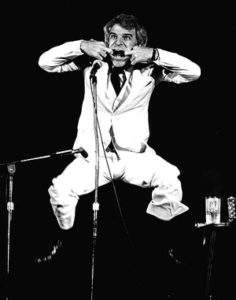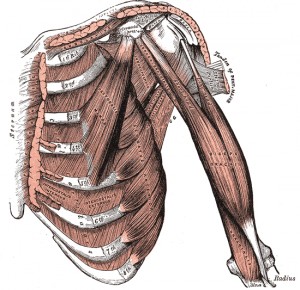
Have you ever had a shoulder injury? If so (or even if not) it’s important to get clear about how your shoulder works so that you don’t re-injure yourself. (www.thisnation.com)
Quite often, learning how to locate your body’s tissues and taking the time to learn a bit about anatomy can make all the difference between keeping your body functional and damaging yourself in Downward Dog. A bum shoulder can make all sorts of everyday movements painful and difficult, so it’s vital to keep yours in working condition.
In this post, I’ll give you the tools to do just that!
Steve Martin: The “wild and crazy” yogi

That reference might date me, and some of you may not remember the genius Martin’s stand-up comedy act, but it’s a great starting point for us to try to grasp the nearly un-graspable variety of movements that a healthy shoulder permits. (Did you notice how many shoulder movements Steve does in his act?!)
Your shoulder has three bones and four joints. But, in the case of the shoulder, three times four does NOT equal 12 movements. You see, shoulder mechanics are not simple math. These joints render more like 14 to 17 movements, depending on which kinesiology text book you consult.
But the number of moves is not nearly as important as the quality of your movements and your connection to those moves. It can be very kinetically confusing to sense how your shoulders are behaving at all times, which brings me back to the “wild and crazy” theme.
Ball and socket and then some
Here comes the anatomy lesson!
Your shoulders have a ball-and-socket joint that permits an unparalleled amount of unrestricted motion. Go ahead— flail your arms around right now to go a little wild and crazy….
That ball-and-socket joint is the bony junction of the long bone of the arm, the humerus, and the floating triangle shaped shoulder bone, the scapula. These two bones give the shoulder its great range of motion. A third bone, the clavicle (your collar bone), hooks the shoulder complex into the sternum so that it doesn’t fly away!
Nearly 20 muscles — from the well-known trapezius and deltoids to the lesser known pectoralis minor — also influence shoulder movements. These muscles are excellent at helping mobilize and stabilize the shoulders, unless they have been rendered dysfunctional. If these muscles are weak, they may have trouble assisting movements or maintaining a position. If they are too strong, they may have trouble lengthening or permitting motions to happen.
Shoulder test: Pranic Bath
Try this total shoulder muscle activator, The Pranic Bath (below and on the Quick Fix for Shoulders video), to help the muscles of your shoulders move your arms into almost every conceivable range of motion. And stay tuned for Friday’s post which comes with a free “Starter Shoulder Range of Motion” kit!
Watch our free Quickfix video for shoulders.
Read Your Mission: Shoulder Range-of-Motion Starter Kit
Learn about our Therapy Ball Programs
[Post reprinted with kind permission from Gaiam Life.]













I think other web site proprietors should take this website as an model, very clean and fantastic user friendly style and design, let alone the content. You’re an expert in this topic!
I love the fluidity in the movement of the Pranic Bath and how it shows the multitude of directions of movement and range of motion our shoulders perform, and also how it helps us assess limitations in that area. Thank you for the concise anatomy lesson!
I first learned the pranic Bath from my yoga teacher who makes it into a fun dance move in class as the disco ball in his studio spins overhead and Madonna plays in the background. Vogue anyone? Love this stretch as a way to warm up my shoulders before our practice beings.
Yes! Pranic Bath!! It shows me precisely where I lack ROM in my shoulders and it’s also a great exercise at the beginning of class as a test of shoulder ROM and then at the end of class to see what kinds of changes students are able to make in their bodies during class.
Great shoulder activator. After doing a bunch of these today I can easily tell where the catches are in the shoulder. Time to hop on the balls.
I am a big believer in closed chain exercises for the upper body muscles and most specifically for the shoulder girdle complex! With closed chain activity, you become aware of how the scapulae sits on your ribs! with that awareness, you can open yourself up to know how to access movements of the shoulder without doing harm! This thought train is good for hose students working on arm balances and inversions.
Thanks for the anatomy lecture Jill. This is easy and simple enough that I can remember. After all the work with our shoulders at Level 1 training, I can literally imagine the inner work of my shoulders every time I use them. It’s a shoulder awakening for me. I’m not only able to feel it, I can imagine how they move. Fascinating!
After trying the shoulder test with my anatomy book by my side, I was easily able to locate the specific muscle causing my shoulder weakness. While you may look silly doing it, this exercise moves your arms into almost every conceivable range of motion helping reveal/isolate the culprit.
YTU really has a lot of novel and excellent shoulder exercises. Misused and overused shoulders build up a lot of tension, which could progress into neck and head problems! It may seems counter-intuitive, but what I found the best way to release shoulder tension is to do a variety of shoulder movements that incorporates both strengthening and stretching (hint hint).
How I love Steve Martin. I see him every once in a while here in the Berkshires and man is he a FOX (with that adjective, I am dating myself) and I have always thought so because of his PHYSICAL COMEDY which (light dawns on…) translates to ROM and propriocention and embodiment!!!
Now to shine that light on the shoulder joint and my own limitations there.
Shoulder RX is the only video I have yet to explore…
INWARD!
Thank you for posting the video of you demoing the Pranic Breath. We did it today in Day 2 of our Level 1 teacher training and it was great to watch you go through it again. I love your enthusiasm for anatomy and your “wild and crazy” spirit.
The shoulder circuitry is so complicated and sensitive that I’ve struggled with understanding it for years. As I recover from a rotator cuff injury, your tips and video are very helpful to me and I thank you. Hope to keep learning more from Yoga Tune Up teachers on my journey.
I really like the Pranic Bath. It’s a simple way to get my whole shoulder girdle “fired up”. I’ve even incorporated it into my bootcamp warmup routine. Thanks Jill!
Shoulders are the most vulnerable joint at crossfit and we always seeking ways to warm them up properly. The shoulder flossing we have covered in today’s Yoga Tune Up TT class will be a great benefit to our athletes. 🙂
I’ll admit that for many years of my practice and even teaching, i thought “shoulder” was merely the top of my arm bone…never really questioned how the shoulder blades fit into that whole concept?! And when i began learning more about the structure and its components (especially through Jill’s Shoulder Helpers) it made me appreciate just how freakin complex the shoulder and its movements are.
Thanks Jill for creating an opportunity to become more aware, and open to the rediscovery of my body and my self. There is clearly always much more to learn!!!!
YTU balls helped me with some major shoulder issues. I have great range of motion in my shoulders, but as I began to strengthen them I had chronic shoulder pain. After gaining very little relief or an answer from a doctor, I found the shoulder and upper back rolling series. Not only did it teach me the anatomy of my rotator cuff, I can now localize my pressure to heal whatever is going on each time I have discomfort. I also enjoy ” dancing with myselt” …the dynamic movement we learned for warming and loosening my shoulders.
This is a light hearted approach to a serious joint. One of the things I love in YTU is how you generate understanding of anatomical facts by asking people to use crazy movements and really let loose. Such a novel way to build proprioception. This approach is refreshing my thinking about my teaching,my practice and even my attitude in life. Thank you.
I never realized how complicated the shoulder muscles and bones were until we broke them down in YTU training today. I have a new awareness of the different movements, and how important it is to properly align them in order to avoid injury, both in a yoga practice and in daily life. Thank you!
I have had a shoulder injury and it has been teaching me lessons ever since. Lately the shoulder work Jill is doing in her Teacher training has been more informative for me that anything else. And reading and responding on this blog has added to the process of studying the body.
Hey Yo-shoulders wow…
What are your thoughts on backpacks Jill? Sometimes I think that they are creating tighter pectoral muscles because they are countering the weight on the back(pack) body and therefore reinforcing the rolling of the shoulders forward. Guess I should stick to my fanny pack…
I learned a lot of anatomy over this weekend from a wonderful teacher Maura Barlclay :). It helped me tremendously to understand my body and improve my yoga practice 🙂
Always a great and informative post from Jill – but this time, thanks to Steve and Jill – practicing some laughter yoga too! Love it! Thanks Jill!